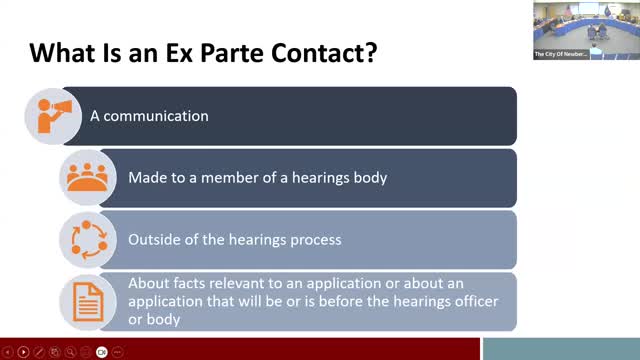ODOT presents urban design verification study proposing lane reconfiguration on Oregon 99 and safety upgrades on East First and Everest
February 23, 2025 | Newberg, Yamhill County, Oregon
This article was created by AI summarizing key points discussed. AI makes mistakes, so for full details and context, please refer to the video of the full meeting. Please report any errors so we can fix them. Report an error »

The Oregon Department of Transportation (ODOT) and consulting firm Parametrix presented a Newberg Urban Design Verification study recommending a lane reconfiguration on the Oregon 99 couplet downtown, pilot protected bike facilities, and targeted crossing upgrades on East First (OR‑219) and Everest Road.
Jenna Berman of ODOT said the study updates past planning work and aims to bring design concepts "a little farther along so they're ready to be leveraged onto another project." Ryan Farncomb, consultant, summarized alternatives and said the team evaluated reducing travel lanes from three to two in each direction through downtown—removing one lane in each direction and repurposing space for bike lanes, buffers and parking. "These lane configurations are proven to reduce vehicle speeds," he said, and the team found traffic impacts would be modest in most locations.
The consultant recommended advancing the lane reconfiguration concept in alignment with local plans and ODOT standards, and suggested near‑term pilot installations using paint and vertical posts to test the design before committing to permanent concrete infrastructure. "The paint and post options was a more near term, lower cost, try it out option," Berman said.
On East First (OR‑219) and Everest, the study recommended near‑term signal or flashing‑beacon upgrades and curb extensions tied to an upcoming ADA ramp project; engineers added an intersection control evaluation and recommended a long‑term roundabout at the Everest/219 crossing based on safety and performance analysis. Berman said the roundabout performed well in comparisons with signal options and provided higher safety benefits; the team noted emergency vehicles and trucks can use mountable center islands where needed.
ODOT and consultants reported strong public engagement—more than 140 comments on the East End segment and more than 70 comments on downtown alternatives. Public commenters in the meeting largely supported improvements; David Hetty of Cycle Yamhill County urged more protected bike lanes and said protected on‑street lanes would make him comfortable escorting children on bicycles. Mallory Butler, a parent, said reducing lanes from three to two downtown would make crossing safer for families.
Councilors pressed for more outreach to the business community, asked about diagonal vs. parallel parking, maintenance responsibilities for state highway changes, and funding prospects. Berman said some striping, signage and ADA ramp work could be funded from existing ODOT pedestrian/bicycle pots and that larger reconfiguration funding would require competitive grants such as Great Streets or other programs. She also said ODOT's maintenance backlog complicates long‑term upkeep and that cities sometimes assume maintenance responsibilities for added features under agreements.
Ending: Council provided general support for advancing the concept and asked staff and ODOT to continue outreach with downtown business organizations, address College Street turning impacts and return with refined options and cost estimates. ODOT said it will seek opportunities to pair near‑term crossing upgrades with a planned ADA project.
Jenna Berman of ODOT said the study updates past planning work and aims to bring design concepts "a little farther along so they're ready to be leveraged onto another project." Ryan Farncomb, consultant, summarized alternatives and said the team evaluated reducing travel lanes from three to two in each direction through downtown—removing one lane in each direction and repurposing space for bike lanes, buffers and parking. "These lane configurations are proven to reduce vehicle speeds," he said, and the team found traffic impacts would be modest in most locations.
The consultant recommended advancing the lane reconfiguration concept in alignment with local plans and ODOT standards, and suggested near‑term pilot installations using paint and vertical posts to test the design before committing to permanent concrete infrastructure. "The paint and post options was a more near term, lower cost, try it out option," Berman said.
On East First (OR‑219) and Everest, the study recommended near‑term signal or flashing‑beacon upgrades and curb extensions tied to an upcoming ADA ramp project; engineers added an intersection control evaluation and recommended a long‑term roundabout at the Everest/219 crossing based on safety and performance analysis. Berman said the roundabout performed well in comparisons with signal options and provided higher safety benefits; the team noted emergency vehicles and trucks can use mountable center islands where needed.
ODOT and consultants reported strong public engagement—more than 140 comments on the East End segment and more than 70 comments on downtown alternatives. Public commenters in the meeting largely supported improvements; David Hetty of Cycle Yamhill County urged more protected bike lanes and said protected on‑street lanes would make him comfortable escorting children on bicycles. Mallory Butler, a parent, said reducing lanes from three to two downtown would make crossing safer for families.
Councilors pressed for more outreach to the business community, asked about diagonal vs. parallel parking, maintenance responsibilities for state highway changes, and funding prospects. Berman said some striping, signage and ADA ramp work could be funded from existing ODOT pedestrian/bicycle pots and that larger reconfiguration funding would require competitive grants such as Great Streets or other programs. She also said ODOT's maintenance backlog complicates long‑term upkeep and that cities sometimes assume maintenance responsibilities for added features under agreements.
Ending: Council provided general support for advancing the concept and asked staff and ODOT to continue outreach with downtown business organizations, address College Street turning impacts and return with refined options and cost estimates. ODOT said it will seek opportunities to pair near‑term crossing upgrades with a planned ADA project.
View full meeting
This article is based on a recent meeting—watch the full video and explore the complete transcript for deeper insights into the discussion.
View full meeting
